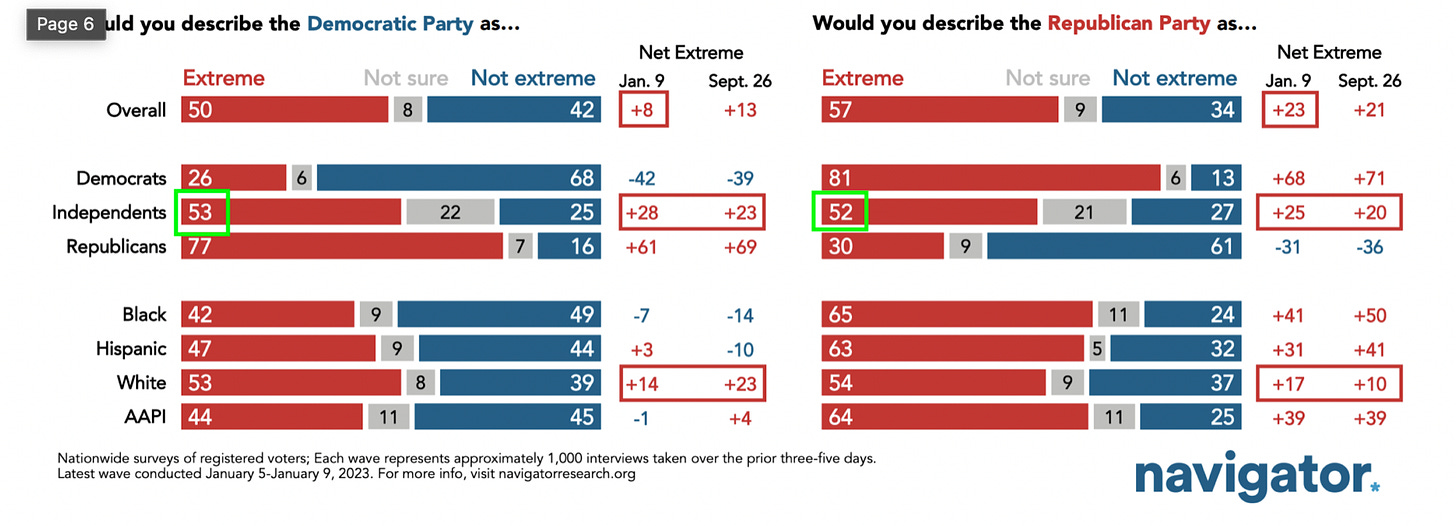Our tour of the 4 types of independents began last week looking at the largest group of independent voters, the “we need more moderates” who constitute about half of all voters who do not identify with either party. These independent voters express serious displeasure with the extremism of the current Democratic and Republican parties, and many of their candidates for office.
More evidence emerged last week from Navigator Research to support this categorization highlighting the primary concern about extremism among roughly half of all independents: for example, 53 percent of independents view the Democratic Party as extreme while 52 percent of independents view the Republican Party in a similar light.
Beyond the pretty solid data about this group of independents who desire more moderation and less extremism in politics, the evidence becomes more speculative and inexact. There simply aren’t that many in-depth and consistent examinations of the core values and shifting opinions of independent voters given their somewhat fluid make-up. After all, majorities or pluralities of independents voted for Barack Obama in 2008, Mitt Romney in 2012, Donald Trump in 2016, and Joe Biden in 2020—obviously not a group of voters easily described by traditional measures of political ideology and policy attitudes.
Looking at the other half of independent voters, those not primarily focused on extremism among the two parties, I estimate roughly one quarter might be categorized as “populist-left” or “populist-right” independents with the final quarter being “disaffected and disengaged” which we will explore next week.
Based on dozens of focus groups and other interviews I’ve participated in over the years with independent voters on numerous issue topics, the overwhelming worldview of populist-left and populist-right independents amounts to: “Everyone in politics is a friggin’ idiot.”
It’s an anti-establishment view that sees both parties as essentially corrupt entities run by people who don’t know what they are doing and who don’t care about what happens to regular Americans. Populist independents simultaneously loathe and laugh at the leaders of both parties who they see as nitwits and sell-outs of middle- and working-class Americans. The populist independents don’t rely on any one ideology. They form their opinions based on their understanding of common sense and how things should work.
The populist-left independents can’t stand the right but focus their ire on “corporate Democrats” who they feel undermine the economic needs of workers and their families in the interests of big business and finance. The populist-right independents mostly direct their anger at Republican elites as either culture war know-it-alls telling people how to live or as patsies for the business class masquerading as defenders of the people.
Populist independents look around their communities and see lots of good people struggling and lots of bad people getting away with rotten things. Both the populist-left and populist-right sides worry a lot about someone else taking advantage of them: either monied elites picking their pockets or other Americans getting handouts while working people get screwed. They are concerned about the decline of good working-class jobs and communities and don’t think anyone in Washington really cares about their situations.
Antipathy to the political class and their consensus views is what unites the populist-left and populist-right independents. They view Washington as a corrupt cesspool of groupthink in the service of corporations and the military industrial complex. They view the media and most institutions as complicit in this worldview, uncritically amplifying the voices and positions of the political class while overlooking deeper problems in society. Milquetoast moderation is the last thing these independents are looking for: many want some undefined radical changes to the American economy and politics that give more power and dignity to regular people while reducing the influence of elites.
As with most populist impulses, the policy views of this one quarter of independents are sometimes hard to pin down. Populist independents can be open to legal immigration or extremely hostile to it. They can support the welfare state or want to end the handouts. They want to both tax the rich and end the regulations blocking small businesses. Populist independents' positions are sometimes quirky so it’s hard for traditional party candidates and leaders to reach them.
Iconoclastic candidates not in the mold of usual politicians often do well with this group. It’s not surprising, for example, that John Fetterman won independent voters in the 2022 Pennsylvania Senate race by a whopping 20 points over Mehmet Oz. Fetterman ran as a “different kind of Democrat” who “doesn’t look like a typical politician” or act like one, and easily emerged as more appealing to populist independents than an out-of-touch rich guy who uses a term like “crudité” in working-class Pennsylvania.
In the end, being a populist independent is more a state of mind rather than the embodiment of a concrete agenda or ideology. Whether they lean more to the left or right in their outlook, the central message from populist independents is the same: “You’re all a bunch of idiots.”






